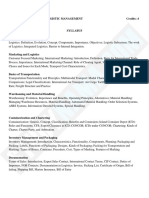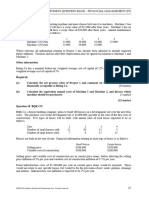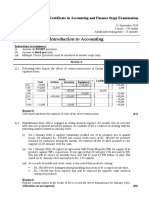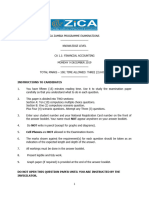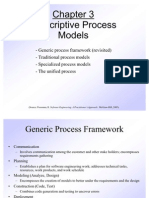Quickbooks From Intuit: Model Iv - Eoq With Quantity Discounts
Quickbooks From Intuit: Model Iv - Eoq With Quantity Discounts
Uploaded by
goforjessicaCopyright:
Available Formats
Quickbooks From Intuit: Model Iv - Eoq With Quantity Discounts
Quickbooks From Intuit: Model Iv - Eoq With Quantity Discounts
Uploaded by
goforjessicaOriginal Description:
Original Title
Copyright
Available Formats
Share this document
Did you find this document useful?
Is this content inappropriate?
Copyright:
Available Formats
Quickbooks From Intuit: Model Iv - Eoq With Quantity Discounts
Quickbooks From Intuit: Model Iv - Eoq With Quantity Discounts
Uploaded by
goforjessicaCopyright:
Available Formats
11/5/13
Operations Research Simplified produced by www.universalteacher.com
QuickBooks From Intuit
quickbooks.in
Intuit QuickBooks is now in India. A Must Software for SMEs. Try Free!
Model IV - EOQ With Quantity Discounts
a) Inventory Model With Single Discount
Recommend
383
Search
The purchase inventory model with single discount may be expressed as
follows:
Order Quantity
Unit Price (Rs.)
1 Q1 < b
P1
b Q2
P2
Following are the steps to summarize the approach.
Steps
1. Compute the optimal order quantity for the lowest price (highest
discount), i.e.,
(2DCo)
-------------ChP2
Q2* =
and compare the value of Q2* with the quantity b which is required to
avail the discount.
If Q2* b, then place orders for quantities of size Q2* and obtain
discount; otherwise move to step 2.
2. Compute Q1* for price P1 and compare TC(Q1*) with TC(b). The values
of TC(Q1*) and TC(b) may be determined as follows:
TC(Q1*) = DP1 + (D/Q1*) X Co + (Q1*/2) X Ch X P1
TC(b) =
DP2 + (D/b) X Co + (b/2) X Ch X P2
If TC(Q1*) > TC(b), then place orders for quantities of size b to get the
discount.
Example
A big cold drinks company, the Piyo - Pilao Company, buys a large number
of pallets every year, which it uses in the warehousing of its bottled
products. A local vender has offered the following discount schedule for
pallets:
Order Quantity
Upto 699
700 and above
Unit Price (Rs.)
10.00
9.00
The average yearly replacement is 2000 pallets. The carrying costs are
www.universalteacherpublications.com/univ/ebooks/or/Ch11/model4.htm
1/4
11/5/13
Operations Research Simplified produced by www.universalteacher.com
The average yearly replacement is 2000 pallets. The carrying costs are
12% of the average inventory and ordering cost per order is Rs. 100.
Solution.
Given
D = 2000 pallets/year, Ch = 0.12, Co = Rs. 100, P1 = Rs. 10, P2 = Rs. 9.00
Step 1
The lowest price (highest discount) is RS. 9.00.
(2 X 2000 X 100)
---------------0.12 X 9
Q2* =
= 608.58 pallets/order
Since Q2* < b (i.e., 608 < 700), Q2* is not feasible.
Step 2
(2 X 2000 X 100)
---------------0.12 X 10
Q1* =
= 577.35 pallets/order
TC(Q1*) = TC(577.35) = 2000 X10 + (2000/577.35) X 100 + (577.35/2 ) X
0.12 X 10
= Rs. 20692.82
TC(b) = TC (700) = 2000 X 9 + (2000/700) X 100 + (700/2) X 0.12 X 9
= Rs. 18663.71
Since TC(b) < TC(Q1*) and hence the optimal order quantity is the price
discount quantity, i.e., 700 units.
b) Inventory model with double discount
Order Quantity
Unit Price (Rs.)
1 Q1 < b1
P1
b1 Q2 < b2
P2
b2 Q3
P3
Where b1 and b2 are the quantities, which determine the price discount.
Following are the steps to summarize the approach.
Steps
1. Compute the optimal order quantity for the lowest price (highest
discount), i.e., Q3* and compare it with b2
a. If Q3* b2, then place order equal to this optimal quantity Q3*
b. If Q3* < b2, then go to step 2
2. Compute Q2* and since Q3* < b2, this implies Q2* is also less than b2.
Thus, either Q2* < b1 or b1 Q2* < b2
a. If Q2* < b2, but b1, then proceed as in the case of single
www.universalteacherpublications.com/univ/ebooks/or/Ch11/model4.htm
2/4
11/5/13
Operations Research Simplified produced by www.universalteacher.com
a. If Q2* < b2, but b1, then proceed as in the case of single
discount, i.e., compare TC(Q2*) and TC(b2) to determine the
optimal purchase quantity.
b. If Q2* < b2 and b1, then move to step 3
3. Compute Q1* and compare TC(b1), TC(b2) and TC(Q1*) to determine
the purchase quantity.
Example
A large dairy firm, the Cow and Buffalo Company, buys bins every year,
which it uses in the warehousing of its bottled products. A local vender
has offered the following discount schedule for bins:
Order Quantity
Upto 699
700 to 949
950 and above
Unit Price (Rs.)
10.00
9
8
The average yearly replacement is 2000 bins. The carrying costs are 12% of the
average inventory and ordering cost per order is Rs. 100.
Solution.
Given
D = 2000 bins/year, Ch = 0.12, Co = Rs. 100, P1 = Rs. 10, P2 = Rs. 9, P3 =
Rs. 8
Step 1
The lowest price (highest discount) is Rs. 8. Thus calculating Q3* =
corresponding to this range as follows:
Q3* =
(2 X 2000 X 100)
---------------0.12 X 8
= 645.49 bins/order
Since Q3* < b2 (i.e., 645.49 < 950), go to step 2 to determine
Q2*
Step 2
Q2* =
(2 X 2000 X 100)
---------------0.12 X 9
= 608.58 bins/order
Again, since Q2* < b2 and b1 (i.e., 608.58 < 950 &
700) go to step 3 to calculate Q1* and compare total
inventory cost corresponding to Q1*, b1 and b2.
Step 3
Q1* =
(2 X 2000 X 100)
---------------0.12 X 10
= 577.35 bins/order
TC(Q1*) = TC(577.35) = 2000 X10 + (2000/577.35) X 100 + (577.35/2 ) X
0.12 X 10
www.universalteacherpublications.com/univ/ebooks/or/Ch11/model4.htm
3/4
11/5/13
Operations Research Simplified produced by www.universalteacher.com
0.12 X 10
= Rs. 20692.82
TC(b1) = TC(700) = 2000 X 9 + (2000/700) X 100 + (700/2) X 0.12 X 9
= Rs. 18663.71
TC(b2) = TC(950) = 2000 X 8 + (2000/950) X 100 + (950/2) X 0.12 X 8
= Rs. 16666.52
The lowest total inventory cost is TC(b2) = Rs. 16666.52 and hence the
optimal order quantity is the price discount quantity of 950 units, i.e., Q*
= b2 = 950 units.
Tw eet
Inventory Service
Inventory Control
It Inventory
Inventory Company
Operations Research Contents
Power distribution units
www.servertech.co.in
Rackmount intelligent PDUs. power management solutions.
universalteacherpublications.com
www.universalteacherpublications.com/univ/ebooks/or/Ch11/model4.htm
4/4
You might also like
- Gann Wave Order Block Trading Master Active Trading With ProvenDocument107 pagesGann Wave Order Block Trading Master Active Trading With Provenjakhotiasarvesh9100% (6)
- PT1 QuestionDocument11 pagesPT1 Questionfengfa2000No ratings yet
- MT760 SBLC DraftDocument1 pageMT760 SBLC DraftEr ErNo ratings yet
- International Logistics ManagementDocument207 pagesInternational Logistics Managementgoforjessica50% (2)
- Unit H/617/1143 Financial and Management Accounting Techniques For Managers Level 4 15 CreditsDocument8 pagesUnit H/617/1143 Financial and Management Accounting Techniques For Managers Level 4 15 Creditsshamshad alamNo ratings yet
- Sep 27 - Practice Problems On ValuationDocument2 pagesSep 27 - Practice Problems On ValuationMost. Amina KhatunNo ratings yet
- The Finance Director of Stenigot Is Concerned About The LaxDocument1 pageThe Finance Director of Stenigot Is Concerned About The LaxAmit PandeyNo ratings yet
- Define The Terms Fixed Cost and Variable CostDocument2 pagesDefine The Terms Fixed Cost and Variable CostSapkota ArjunNo ratings yet
- Investment Appraisal Taxation, InflationDocument8 pagesInvestment Appraisal Taxation, InflationJiya RajputNo ratings yet
- Ia MTQSDocument14 pagesIa MTQSChoudhrist100% (1)
- Chapter Two Materials ManagementDocument40 pagesChapter Two Materials ManagementYeabsira WorkagegnehuNo ratings yet
- QuestionsDocument10 pagesQuestionsYat Kunt ChanNo ratings yet
- Paper T10 Managing Finances: Sample Multiple Choice Questions - June 2009Document174 pagesPaper T10 Managing Finances: Sample Multiple Choice Questions - June 2009Khánh LyNo ratings yet
- PM January 2021 Lecture 4 Worked Examples Questions (Drury (2012), P. 451, 17.17)Document6 pagesPM January 2021 Lecture 4 Worked Examples Questions (Drury (2012), P. 451, 17.17)KAY PHINE NGNo ratings yet
- 62 BIWS Bank Valuation PDFDocument6 pages62 BIWS Bank Valuation PDFsm1205No ratings yet
- SDG 11 Synthesis Report - Web2 PDFDocument128 pagesSDG 11 Synthesis Report - Web2 PDFMeitar KeshetNo ratings yet
- Corporate Strategy of Nirala Sweets,,,Presentation.Document22 pagesCorporate Strategy of Nirala Sweets,,,Presentation.Mirza Umer Mehmood100% (1)
- 2 - CH 16 (ICAP Book) - Introduction To Project Appraisal - FinalDocument93 pages2 - CH 16 (ICAP Book) - Introduction To Project Appraisal - FinalArslanNo ratings yet
- Ques On Capital BudgetingDocument5 pagesQues On Capital BudgetingMonika KauraNo ratings yet
- ACCA F9 Revision Question Bank-49-51Document3 pagesACCA F9 Revision Question Bank-49-51rbaamba100% (1)
- Exercises Budgeting ACCT2105 3s2010Document7 pagesExercises Budgeting ACCT2105 3s2010Hanh Bui0% (1)
- Cash Management NumericalsDocument5 pagesCash Management NumericalsAnjali Jain100% (1)
- BudgetingDocument23 pagesBudgetingAbdul HaleemNo ratings yet
- CH 12Document3 pagesCH 12ghsoub777No ratings yet
- Throughput AccountingDocument12 pagesThroughput AccountingSaqib Akhtar100% (3)
- Special Inventory MGMT ModelsDocument42 pagesSpecial Inventory MGMT ModelsPradeep SethiaNo ratings yet
- Net Present Value MCQ's & Descriptive TAEDocument45 pagesNet Present Value MCQ's & Descriptive TAEJames MartinNo ratings yet
- CAF 1 IA Autumn 2020Document5 pagesCAF 1 IA Autumn 2020Qasim Hafeez KhokharNo ratings yet
- ACFI7007 Consolidation Test 3Document6 pagesACFI7007 Consolidation Test 3Anna ThomasNo ratings yet
- Chapter 9 Divisional Transfer PricingDocument36 pagesChapter 9 Divisional Transfer PricingPranav ChandraNo ratings yet
- Review of FA3Document9 pagesReview of FA3ngquynhanh3110No ratings yet
- Symbiosis Center For Management & HRDDocument3 pagesSymbiosis Center For Management & HRDKUMAR ABHISHEKNo ratings yet
- 223 Woodbank CoDocument3 pages223 Woodbank CoLinh MitNo ratings yet
- Replacement Project AnalysisDocument6 pagesReplacement Project Analysisdineshpasa76074No ratings yet
- Standard CostingDocument18 pagesStandard Costingpakistan 123No ratings yet
- Branch Accounting PDFDocument18 pagesBranch Accounting PDFSivasruthi DhandapaniNo ratings yet
- CH # 8 (By Product)Document10 pagesCH # 8 (By Product)Rooh Ullah KhanNo ratings yet
- P2 Financial Management June 2012Document9 pagesP2 Financial Management June 2012Subramaniam KrishnamoorthiNo ratings yet
- 01 LeveragesDocument11 pages01 LeveragesZerefNo ratings yet
- Accounting For Hire Purchase SystemDocument42 pagesAccounting For Hire Purchase Systemfarhanansari2664No ratings yet
- Cash BudgetDocument4 pagesCash BudgetSANDEEP SINGH0% (1)
- Chapter 07 - Exercises - Part IIDocument4 pagesChapter 07 - Exercises - Part IIRawan YasserNo ratings yet
- Decision Tree-Cap BudDocument5 pagesDecision Tree-Cap BudShipra JainNo ratings yet
- Forex Exchange Rate Risk Review QuestionsDocument14 pagesForex Exchange Rate Risk Review QuestionsEdga WariobaNo ratings yet
- MA PYQ'sDocument36 pagesMA PYQ'sbokachodasoumen6No ratings yet
- Appendix GDocument3 pagesAppendix GYardie TreyBwoy100% (1)
- Qa Ca Zambia Programme December 2019 ExaminationDocument449 pagesQa Ca Zambia Programme December 2019 ExaminationimasikudenisiahNo ratings yet
- Ias 40Document20 pagesIas 40Reever RiverNo ratings yet
- MA-II Assignment V - Short Run Decision AnalysisDocument4 pagesMA-II Assignment V - Short Run Decision Analysisshriya2413No ratings yet
- Sir Saud Tariq: 13 Important Revision Questions On Each TopicDocument29 pagesSir Saud Tariq: 13 Important Revision Questions On Each TopicShehrozST50% (2)
- T5-June 2013-TAXATIONDocument24 pagesT5-June 2013-TAXATIONMosesNo ratings yet
- Cash BudgetDocument3 pagesCash Budgetmanoj kumarNo ratings yet
- M 2012 June PDFDocument21 pagesM 2012 June PDFMoses LukNo ratings yet
- Revaluation of Partnership AssetsDocument32 pagesRevaluation of Partnership AssetsERICK MLINGWA100% (1)
- CA IPCC Costing Nov 14 Guideline Answers PDFDocument13 pagesCA IPCC Costing Nov 14 Guideline Answers PDFmohanraokp2279No ratings yet
- IntermediateDocument139 pagesIntermediateabdulramani mbwanaNo ratings yet
- CA Ipcc - Costing - May 2019 - Suggested AnswersDocument30 pagesCA Ipcc - Costing - May 2019 - Suggested Answerssainaraien2001No ratings yet
- Cma Vol IiDocument459 pagesCma Vol Iieexpert075No ratings yet
- Extracted Chapter 1Document103 pagesExtracted Chapter 1PalisthaNo ratings yet
- Economic Order Quantity (EOQ) - Practical Problems and SolutionsDocument18 pagesEconomic Order Quantity (EOQ) - Practical Problems and SolutionsahmedNo ratings yet
- Cap II Group I RTP June 2024Document82 pagesCap II Group I RTP June 2024nysasunuwar44No ratings yet
- Chapter 4Document15 pagesChapter 4Arun Kumar SatapathyNo ratings yet
- M 2010 and 2011 June PDFDocument91 pagesM 2010 and 2011 June PDFMoses LukNo ratings yet
- Make or Buy DecisionDocument20 pagesMake or Buy DecisionNitin Agarwal100% (1)
- Cost Of Capital A Complete Guide - 2020 EditionFrom EverandCost Of Capital A Complete Guide - 2020 EditionRating: 4 out of 5 stars4/5 (1)
- Various Inventory Costs: - Holding / - Ordering Costs - Purchase Costs - Total CostDocument28 pagesVarious Inventory Costs: - Holding / - Ordering Costs - Purchase Costs - Total CostAditya Dashputre100% (2)
- The Production Qauntity ModelDocument21 pagesThe Production Qauntity ModelVibhor AggarwalNo ratings yet
- Question PaperDocument8 pagesQuestion PapergoforjessicaNo ratings yet
- Teaching Diary A Tool For An Effective TDocument5 pagesTeaching Diary A Tool For An Effective TgoforjessicaNo ratings yet
- HRMDocument18 pagesHRMgoforjessicaNo ratings yet
- Compensation FormatDocument1 pageCompensation FormatgoforjessicaNo ratings yet
- Linear Programming ExamplesDocument7 pagesLinear Programming ExamplesgoforjessicaNo ratings yet
- Pressman CH 3 Prescriptive Process ModelsDocument32 pagesPressman CH 3 Prescriptive Process Modelsgoforjessica100% (1)
- Assignment 1 JapneetDocument13 pagesAssignment 1 JapneetgoforjessicaNo ratings yet
- Chapter - 04 Software Process and Project MetricsDocument18 pagesChapter - 04 Software Process and Project MetricsgoforjessicaNo ratings yet
- What Is A FirewallDocument13 pagesWhat Is A FirewallgoforjessicaNo ratings yet
- Routing For Mobile HostsDocument4 pagesRouting For Mobile Hostsgoforjessica100% (1)
- The Impact of Liberalisation and Privatisation in India Economy SeminarDocument5 pagesThe Impact of Liberalisation and Privatisation in India Economy SeminargoforjessicaNo ratings yet
- GoI, Annual Report, IT, 2008-09Document116 pagesGoI, Annual Report, IT, 2008-09Deepak PareekNo ratings yet
- Chapter 8 Part TwoDocument19 pagesChapter 8 Part TwoAbdelnasir HaiderNo ratings yet
- Explorations in Economics: Alan B. Krueger & David A. AndersonDocument30 pagesExplorations in Economics: Alan B. Krueger & David A. AndersonZaw Ye HtikeNo ratings yet
- Provisional Program v2Document12 pagesProvisional Program v2Marios ZepseNo ratings yet
- Organizational Behaviour: BBA (B&I) GGS Indraprastha University BBA (B&I) 201Document31 pagesOrganizational Behaviour: BBA (B&I) GGS Indraprastha University BBA (B&I) 201Rahul SethNo ratings yet
- Why Civil Engineering Is Important?Document13 pagesWhy Civil Engineering Is Important?Ruben LujoNo ratings yet
- (Assignment) Finc 331 Project 1Document6 pages(Assignment) Finc 331 Project 1Nashon ChachaNo ratings yet
- Pre Termination of LongDocument5 pagesPre Termination of LongBisag AsaNo ratings yet
- Operating ExposureDocument31 pagesOperating ExposureMai LiênNo ratings yet
- Amar Singh CV (2) - 2Document2 pagesAmar Singh CV (2) - 2Rajiv SaxenaNo ratings yet
- SAP Best Practices: Telecommunications US V1.600: Solution ScopeDocument19 pagesSAP Best Practices: Telecommunications US V1.600: Solution ScopeongkecanthoNo ratings yet
- Organization of Factories of East India CompanyDocument5 pagesOrganization of Factories of East India Companyanchal singhNo ratings yet
- World Congress 2024 BookletDocument16 pagesWorld Congress 2024 Bookletcontact.kolweziaNo ratings yet
- Corporate Dividend Policy of Standard Bank GroupDocument29 pagesCorporate Dividend Policy of Standard Bank GroupTivyaanga Chandra MohanNo ratings yet
- Domenestrating The Value of MarketingDocument19 pagesDomenestrating The Value of MarketingmoatazNo ratings yet
- RPJPN 2005-2025Document91 pagesRPJPN 2005-2025Klinik KalitanjungNo ratings yet
- Chapter 18Document9 pagesChapter 18Michelle MenesNo ratings yet
- The Goodparts Company Produces A Component That Is Subsequently UsedDocument1 pageThe Goodparts Company Produces A Component That Is Subsequently UsedAmit PandeyNo ratings yet
- Business Finance AssingmentDocument29 pagesBusiness Finance AssingmentShivaniNo ratings yet
- Bài tập chương 3 Financil ratiosDocument14 pagesBài tập chương 3 Financil ratiosThu LoanNo ratings yet
- Lesco 3Document1 pageLesco 3Dr. Tanvir ZaverNo ratings yet
- Entrepreneurial Pathways: An OverviewDocument7 pagesEntrepreneurial Pathways: An OverviewtahaalkibsiNo ratings yet
- The Impact of Multinational EnterprisesDocument28 pagesThe Impact of Multinational EnterprisesfalconshaheenNo ratings yet
- Thinking of Working For Yourself?Document17 pagesThinking of Working For Yourself?StaceyNo ratings yet
- Roberta Capello, Peter Nijkamp - Handbook of Regional Growth and Development Theories-Edward Elgar (2009) - 1-130Document130 pagesRoberta Capello, Peter Nijkamp - Handbook of Regional Growth and Development Theories-Edward Elgar (2009) - 1-130badztmaruuNo ratings yet



